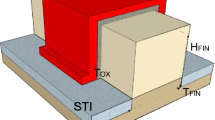Abstract
Density’s increase in Static Random Access Memory (SRAM) has become an important concern for testing, since new types of defects, that may occur during the manufacturing process, are introduced. On the one hand, new manufacturing defects may lead to dynamic faults, which are considered one of the most important causes of test escape in deep-submicron technologies. On the other hand, the SRAM’s robustness is considered crucial, since it may affect the entire SoC. One of the most important phenomena to degrade SRAM reliability is Negative-Bias Temperature Instability (NBTI) causing the memory cells’ aging. In this context, the paper proposes to analyse the impact of NBTI on SRAM cells with resistive defects that eventually escape manufacturing test and, with aging, may generate faults over time. Finally, SPICE simulations adopting a commercial 65 nm CMOS technology library have been performed in order to estimate NBTI’s precise impact over time.




























Similar content being viewed by others
References
Agarwal M, Paul BC, Ming Z, Mitra S (2007) Circuit failure prediction and its application to transistor aging. Proc. 25th IEEE VLSI Test Symposium, pp 277–286
Agarwal M, Balakrishnan V, Bhuyan A, Kim K, Paul BC (2008) Optimized circuit failure prediction for aging: practicaity and promise. Proc. IEEE Inteernational Test Conference, 2008 (ITC 2008), Santa Clara. https://doi.org/10.1109/TEST.2008.4700619
Alam MA, Roy K, Augustine C (2008) Reliability- and process-variation aware design of integrated circuits — a broader perspective. Proc. IEEE International Reliability Physics Symposium (IRPS), Monterey. https://doi.org/10.1109/IRPS.2011.5784500
Boning D, Nassif S (2000) Models of process variations in device and interconnect, design of high performance microprocessor circuits. IEEE Press, pp 98–115. https://doi.org/10.1109/9780470544365.ch6
Borkar S (2005) Designing reliable systems from unreliable components: the challenges of transistor variability and degradation. IEEE Micro 25(6):10–16
Bosio A, Dilillo L, Girard P, Pravossoudovitch S, Virazel A (2012) Advanced test methods for SRAMs, Proc. IEEE 30th VLSI Test Symposium (VTS), 2012, pp 300–301
Calimera A, Macii E, Poncino M (2010) NBTI-aware clustered power gating. ACM Trans Des Autom Electron Syst 16(1):3
Ceratti A, Copetti T, Bolzani Poehls L, Vargas F (2012) Investigating the use of an on-chip sensor to monitor NBTI effect in SRAM. Proc. IEEE 13th Latin-American Test Workshop (LATW), Washington, pp 1–6
Fonseca RA, Dilillo L, Bosio A, Girard P, Pravossoudovitch S, Virazel A, Badereddine N (2010) Analysis of resistive-bridging defects in SRAM core-cells: a comparative study from 90nm down to 40nm technology nodes. Proc. IEEE 15th European test symposium (ETC), Praha, pp 132–137
Kumar SV, Kim CH, Sapatnekar SS (2009) Adaptive techniques for overcoming performance degradation due to aging in digital circuits. Proc. Asia and South Pacific Design Automation Conference (ASP-DAC), Yokohama, pp 284–289
Mahapatra S, Saha D, Varghese D, Kumar PB (2006) On the generation and recovery of interface traps in MOSFETs subjected to NBTI, FN, and HCI stress. IEEE Trans Electron Devices 53(7):1583–1592
Martins CV, Semão J, Vazquez JC, Champac V, Santos M, Teixeira IC, Teixeira JP (2011) Adaptive Error-Prediction Flip-flop for performance failure prediction with aging sensors. Proc. IEEE 29th VLSI Test Symposium, Dana Point, pp 203–208
PHILIPS (1998) 74rHC/HCT181 4-Bit arithmetic logic unit. Datasheet. http://www.alldatasheet.com/view.jsp?Searchword=74hct
Siddiqua T, Gurumurthi S, Stan MR (2011) Modeling and analyzing NBTI in the presence of process variation. Proc. 12th International Symposium on Quality Electronic Design (ISQED), Santa Clara, pp 1–8
Tulio Martins M, Cardoso Medeiros G, Copetti T, Vargas F, Bolzani Poehls LM (2016) Analyzing NBTI impact on SRAMs with resistive-open defects. Proc. IEEE 17th Latin-American Test Symposium (LATS), Foz do Iguacu, pp 87–92. https://doi.org/10.1109/LATW.2016.7483345
Vasquez JC, Champc V, Ziesemer AM Jr, Reis R, Semião J, Teixeira JP (2010) Predictive error detection by on-line aging monitoring. Proc. IEEE 16th International On-Line Testing Symposium (IOLTS), Corfu, pp 9-14. https://doi.org/10.1109/IOLTS.2010.5560241
Author information
Authors and Affiliations
Corresponding author
Additional information
Responsible Editor: K. K. Saluja
Rights and permissions
About this article
Cite this article
Martins, M.T., Medeiros, G.C., Copetti, T. et al. Analysing NBTI Impact on SRAMs with Resistive Defects. J Electron Test 33, 637–655 (2017). https://doi.org/10.1007/s10836-017-5685-6
Received:
Accepted:
Published:
Issue Date:
DOI: https://doi.org/10.1007/s10836-017-5685-6




